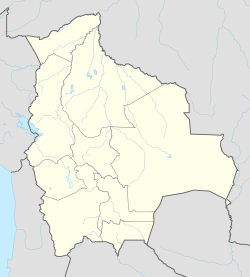Cachuela Esperanza facts for kids
Quick facts for kids
Cachuela Esperanza
|
|
|---|---|
| Country | |
| Department | Beni Department |
| Province | Vaca Díez Province |
| Municipality | Guayaramerín Municipality |
| Elevation | 440 ft (134 m) |
| Population
(2001)
|
|
| • Total | 1,364 |
| Time zone | UTC-4 (BOT) |
Cachuela Esperanza is a small village in the Beni Department of Bolivia. Its name means "rapids of hope." This village is known for its interesting past, especially during the time of the "rubber boom."
Contents
Where is Cachuela Esperanza?
Cachuela Esperanza is located on the right side of the Beni River. It sits right next to some fast-moving water called "rapids." The village is about 30 kilometers (18 miles) from where the Beni River joins the Mamoré River. Together, these two rivers form the much larger Madeira River. The village is about 134 meters (440 feet) above sea level. You can only reach it by driving on dirt roads.
A Glimpse into History: The Rubber Boom Town
The area around the Beni River rapids was first found in 1846. A Bolivian scientist named José Agustín Palacios discovered it. Later, a very important time called the "rubber boom" began. During this time, natural rubber was in high demand and very valuable.
Because of the rubber boom, a powerful businessman named Nicolas Suárez Callaú chose Cachuela Esperanza as the main office for his huge rubber company. This company was so big it had offices in many places. These included Acre in Brazil, the cities of Manaus and Belém, and even London, England.
Nicolas Suárez Callaú made Cachuela Esperanza a very modern and fancy town. He built a theater for shows and tennis courts for sports. There was also a luxurious hotel that looked out over the rapids. He even built a modern hospital. This hospital was special because it had Bolivia's very first X-ray machine! Rich people from cities like Rio de Janeiro and São Paulo would fly in on seaplanes to visit.
However, in the 1920s, things started to change. People began using "synthetic rubber," which is man-made rubber. This new rubber slowly replaced natural rubber. As a result, Cachuela Esperanza became less important. After the Bolivian Revolution in 1952, the town lost its special status completely. It became a quiet, ordinary village.
Who Lives There Now?
Today, Cachuela Esperanza is much smaller. It has only about 200 people living there. In the past, the most famous person from the town was Nicolas Suárez Callaú. He was known as the "rubber king." He was one of the most powerful business leaders in Bolivia.
Another important person born in Cachuela Esperanza was Eugen Gomringer. He was born in 1925. His father was Swiss and his mother was Bolivian. Eugen Gomringer is known as the "father of Concrete Poetry." This is a type of poetry where the way the words are arranged on the page is just as important as their meaning.
See also
 In Spanish: Cachuela Esperanza para niños
In Spanish: Cachuela Esperanza para niños


